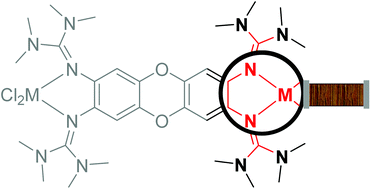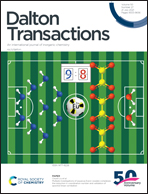On the metal–ligand bonding in dinuclear complexes with redox-active guanidine ligands†
Abstract
Coordination compounds with redox-active ligands are currently intensively studied. Within this research theme, redox-active guanidines have been established as a new, eminent class of redox-active ligands. In this work the variation of metal-guanidine bonding in dinuclear transition metal complexes with bridging redox-active tetrakisguanidine ligands is analysed. A series of dinuclear complexes with different metals (Mn, Fe, Co, Ni, Cu and Zn) is synthesized, using either newly prepared redox-active tetrakisguanidino-dioxine or previously reported tetrakisguanidino-benzene ligands. The discussion of the bond properties in this work is predominantly based on the trends of structural parameters, derived from determination of single-crystal structures by X-ray diffraction and quantum chemical calculations. In addition, the trends in the redox potentials and magnetometric (SQUID) measurements on some of the complexes are included. Due to their combined σ- and π-electron donor capability, redox-active guanidine ligands are weak-field ligands; the σ- and π-bonding contributions vary with the metal. The results highlight the peculiarity of copper-guanidine bonding with a high π-bond contribution to metal-guanidine bonding, enabled by structural distortion of the coordination mode from tetrahedral in the direction of square-planar, short copper-guanidine bonds and minor displacement of the copper atoms from the ligand aromatic plane.



 Please wait while we load your content...
Please wait while we load your content...